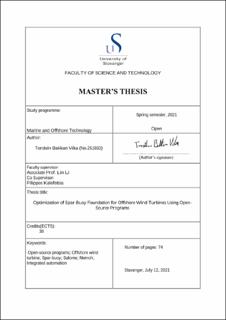| dc.description.abstract | Low carbon and renewable energy are paramount to tackle climate change and supply the increasing energy demand in a sustainable way. In recent years, the offshore wind industry has attracted growing attention for its floating wind turbines as a competitive new renewable energy source. By utilising deep-water sites, offshore wind has the potential to become a major contributor to the global energy market.
In this thesis an optimization study on Spar-Buoy foundations is performed using the open-source software’s Salome, Nemoh and Python. An automated procedure is created to simulate the hydrodynamic properties for a large number of geometries with different variables. The procedure generates the mesh models, calculates the hydrostatic properties, and uses the results as input to simulate the hydrodynamic properties. Further the geometries are subjected to four performance criteria’s considering the static heeling angle, metacentric height (GM) ̅, 3-hour maximum pitch angle and acceleration at the nacelle. The geometries are evaluated in five different environmental conditions, considering cut-in, rated, close to cut-out and cut-out wind speeds as well as 50-year extreme wave conditions. Lastly the geometries are optimized by two objective functions, one is a cost function and the other one is a stability function considering the (GM) ̅. These are then evaluated by applying the weighted sum method, creating a combined objective function where weight’s w_1 and w_2 is applied to the objective functions. The optimum geometry is then found by analysing the different optimums.
The results imply that a larger Spar-Buoy have larger hydrodynamic responses, whereas the static stability is improved. The combined objective function imply that a tall slender geometry would provide the best trade-off between cost and static stability. Whereas, the automated simulation procedure provides a foundation for optimisation study’s using open-source software’s. | |
